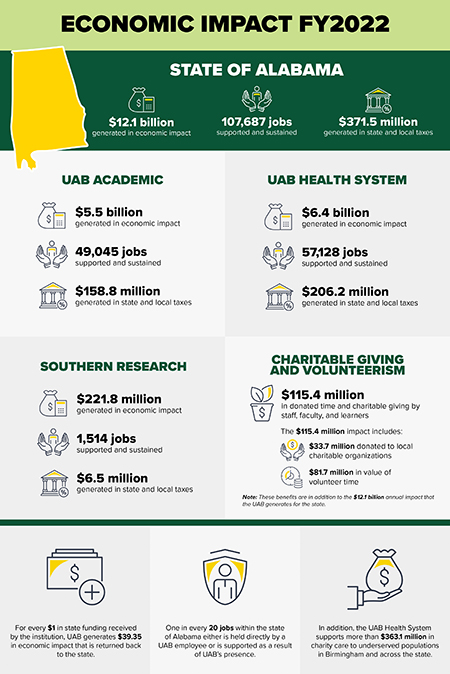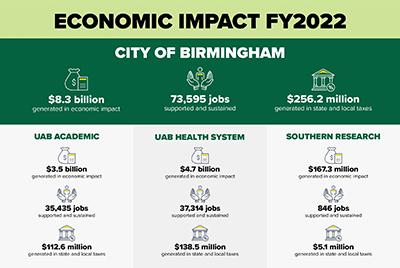
Click photo to enlarge
A new report shows the University of Alabama at Birmingham’s annual economic impact in Alabama grew from $4.6 billion in 2008 and $7.15 billion in 2016 to $12.1 billion in 2022 — a 61 percent increase since 2016 and a 163 percent increase since 2008.
In 2022, UAB generated more than $371 million in state and local taxes and supported or sustained 107,600 jobs in Alabama, up from 64,000 six years ago. In Birmingham alone, UAB generated $8.3 billion in economic impact, supported or sustained 73,595 jobs, and generated more than $256 million in local taxes.
According to the report, “UAB is the most significant single contributor to the Alabama economy and the leading generator of jobs.”
UAB President Ray L. Watts announced the results of the new economic impact study conducted by Tripp Umbach during his presentation at the University of Alabama System Board of Trustees meeting at UAB Hill Student Center on Feb. 3.
“We are proud that our positive impact in Alabama and on Alabamians continues to grow with the active partnership and support of the University of Alabama System Office and UA System Board of Trustees,” Watts said. “We exist to improve lives, and this report is evidence of our growing impact.”
UAB is Alabama’s largest single employer and now directly employs nearly 28,000 people. One in every 20 jobs within the state of Alabama either is held directly by a UAB employee or is supported as a result of UAB’s presence.
“The rapid growth of UAB’s economic impact has far exceeded our expectations,” said UAB Senior Vice President for Finance and Administration Brian Burnett. “This report is proof that Forging the Future, UAB’s strategic plan led by President Watts and supported by our talented students, faculty, staff, alumni and supporters, continues to guide our institution’s purposeful growth to unprecedented results.”
UA System Chancellor Finis St. John says the report demonstrates a tremendous positive return on investment for public officials, business leaders and individuals looking to fund initiatives that make a difference.
“The University of Alabama System campuses continue to serve our state well, and UAB’s new economic impact study is further proof that dollars invested in our institutions deliver a tremendous positive return on investment for our state,” St. John said. “According to the report, UAB generates $39.35 in economic impact returned to the state for every $1 in state funding the institution receives. That return is up from $25 in 2016.”
UAB’s academic enterprise generated $5.5 billion in statewide economic impact, while the UAB Health System generated $6.4 billion. UAB’s charitable giving and volunteerism were estimated to deliver $115.4 million in statewide impact, up from $80.5 million in 2016. UAB affiliate Southern Research generated $221.8 million in statewide economic impact, supported and sustained 1,514 jobs, and generated $206.2 million in state and local taxes.

Click photo to enlarge“Our economic impact continues to grow across all areas of our mission thanks to our talented students, faculty, staff, alumni and supporters,” Watts said. “While important, economic impact is only one way we contribute to our city, state and beyond. As much as we focus on that impact, we will continue to focus on the positive impact we can have on people across our education, research, patient care and community service missions.”
Tripp Umbach is an experienced provider of conducting economic impact studies, community needs assessments, feasibility studies and strategic planning for various clients, including colleges/universities, hospitals, medical schools, academic medical centers, industry associations, and economic development organizations. Tripp Umbach has completed consulting assignments for more than 1,000 clients worldwide. Tripp Umbach’s clients include academic medical centers, such as Cleveland Clinic, University of Michigan, University of Iowa, University of Pittsburgh Medical Center, Penn Medicine, Johns Hopkins University, University of Nebraska Medical Center, Ohio State University Wexner Medical Center, University of Washington, University of Minnesota, UF Health Shands Hospital and University of California San Francisco Medical Center.